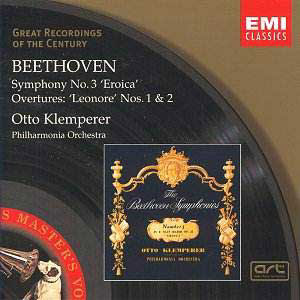The deceptive thing about the greatest art is that it seems
ridiculously easy. Take the first movement of Klemperer’s 1955 (mono)
"Eroica". All the conductor need do is pick a tempo which lets
the crotchets stride ahead purposefully and just let it go by itself.
Ah yes, but to get it all this right … Richard Osborne, a longstanding
and fervent, but unblinkered, admirer of Klemperer, tells us how Karajan
– not a man remembered for his modesty – came into Klemperer’s dressing-room
after a performance of this symphony in 1957 and said "I have simply
come to thank you and to say that I hope I shall live to conduct the Funeral
March as well as you have done it".
It is not just a question, in the first movement, of
picking a tempo and holding it steady, it is a question of making each
idea grow out of the previous one, of making every detail, large or
small (and you will hear many that are often lost in the general welter
of sound) fall into its exact place in the scheme so that the whole
vast movement moves proudly and inevitably from beginning to end in
one single sweep.
And then, as Osborne points out, Klemperer seems unusually
fast at the beginning of the Funeral March. Well, how many times have
we heard this moved launched (or rather beached at the outset) at a
tempo so slow it could never be held (or tolerated) all through. With
Klemperer every episode grows out of the last, and the sheer rightness
of the return of the opening theme, to its new accompaniment of semiquaver
triplets, without the need for the slightest adjustment to the tempo,
is unforgettable.
The Scherzo may seem slow at first, but the result
is actually of great vitality. So often this movement starts as a sort
of amorphous whisper, acquiring rhythm only when the forte breaks
out. Klemperer insists on very precise articulation and makes us hear
where the first beat of the bar is. In fact, when the effect is not
so much the usual one-in-a-bar but of three beats in a bar that go like
the wind, you end up by finding this a wonderfully vivacious performance.
And needless to say, the trio sounds absolutely right without the smallest
adjustment in tempo (and no romantic slowing towards the end).
In the finale Klemperer succeeds in presenting a seamless
argument; as the poco andante begins he broadens his stride but there
is not the usual sense that the movement is divided into two parts.
More intangible is the feeling that over and above this each single
movement rises out of the one before; the symphony is presented in one
great unbroken line.
Of the overtures I will only say that I had previously
thought Leonore no. 1 to be rather run-of-the-mill Beethoven. No longer.
And Klemperer also convinced me that no. 2 has its own raison d’être,
rather than being a long-winded first stab at the more succinct no.
3.
What a wonderful orchestra the Philharmonia was at
this time. Some of Britain’s finest wind players (in particular) are
to be heard here, each with his own individuality and yet welded into
a perfect whole. The recording has such presence that I hardly noticed
it was mono.
Some questionable offerings have found their way into
the EMI Classics "Great Recordings of the Century" series,
but this (even if you have the later stereo remake) is one of the essential
Beethoven recordings.
Christopher Howell


